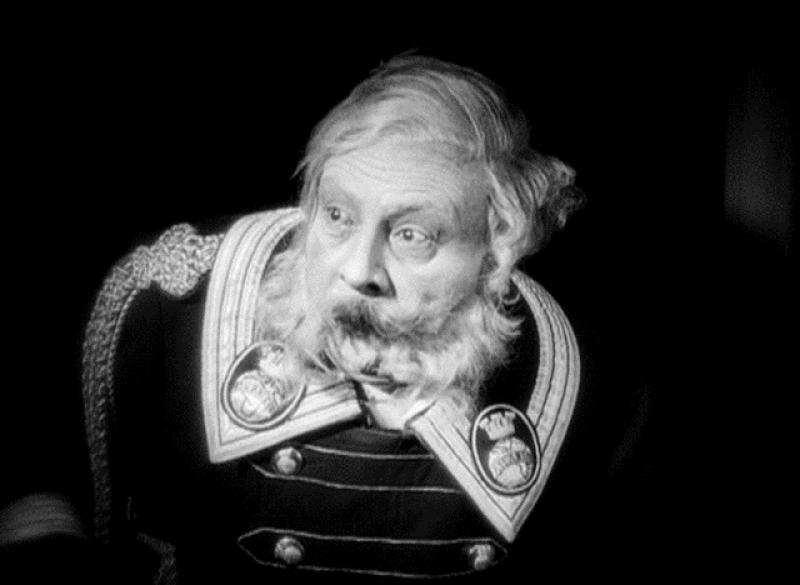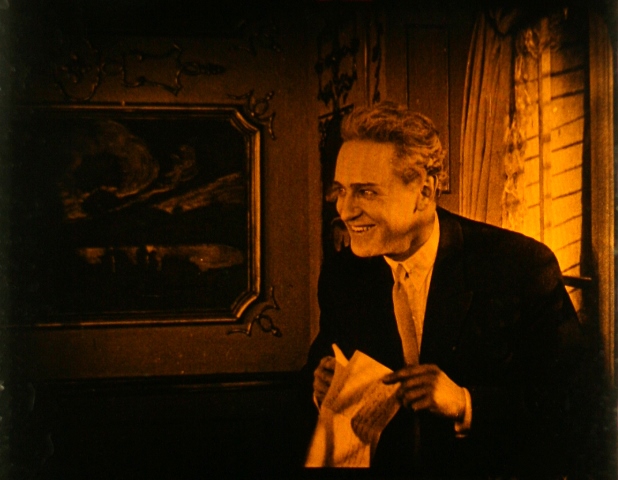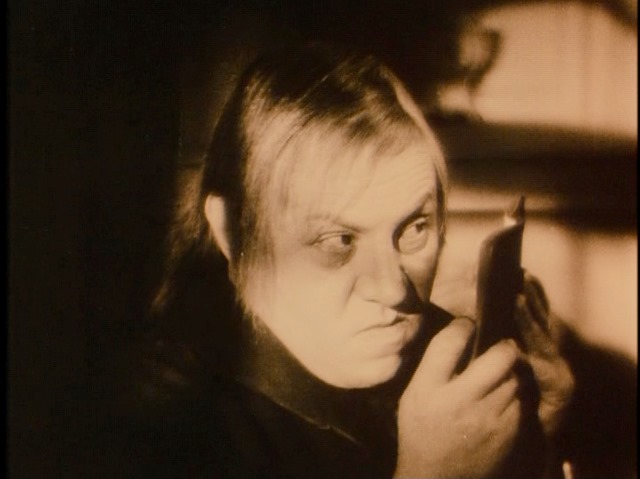Blu-ray: Early Murnau | reviews, news & interviews
Blu-ray: Early Murnau
Blu-ray: Early Murnau
Five films from the great German director offer insights into his inconsistency

“FW Murnau’s work is, at first glance, the most varied, even inconsistent, of the great German cineastes.” Those are the opening words of film critic David Cairns's What Will You Be Tomorrow? an extra conceived for Early Murnau: Five Films, 1921-1925, a new three-disc Blu-ray box set of the director’s early films. After watching them, it’s clear that what might seem a contentious statement is spot on.
There is no expressionist horror like 1922’s Nosferatu, eine Symphonie des Grauens nor intense romantic drama akin to Murnau’s first American film, 1927’s Sunrise: A Song of Two Humans. Instead, there is a comedic exposition of gentry on their downers in a world where money buys a revolution, a horror-tinged whodunit, a drama of misguided passion, a tale of sudden loss of status, and a free-wheeling adaptation of Molière’s Tartuffe.
 Of course, as Cairns goes on to say, stylistic elements unite these silent films, all from before Murnau's move from Germany to America. Each has a recognisably expressionist take on its characters and the world in which they exist. Motifs recur across films. Each is also a cautionary tale in social morals with characters pretending to be what they are not. Nonetheless, watching them together does bring home the fact that Murnau was, indeed, inconsistent.
Of course, as Cairns goes on to say, stylistic elements unite these silent films, all from before Murnau's move from Germany to America. Each has a recognisably expressionist take on its characters and the world in which they exist. Motifs recur across films. Each is also a cautionary tale in social morals with characters pretending to be what they are not. Nonetheless, watching them together does bring home the fact that Murnau was, indeed, inconsistent.
Schloß Vogelöd: Die Enthüllung eines Geheimnisses (1921: The Haunted Castle aka Castle Vogelöd: The Revelation of a Secret) is the earliest of the films and the horror-tinged Agatha Christie-style excursion. Reviewed on theartsdesk, it was declared “a stately, atmospheric meditation that’s capable of giving the willies”, a conclusion which stands. Phantom (1922) was made and released just after Nosferatu. A bizarre drama of injudicious love involving a would-be poet town clerk and his fixation with a woman he has seen once, it’s a cautionary tale of how loss of reason can lead to a swift downfall. Its surreal phantom carriage sequence is unforgettable.
Die Finanzen des Großherzogs (1924: The Grand Duke's Finances, pictured above right) is the one where money instigates revolution, on a Mediterranean island ruled by a debt-laden Duke. This curio tackles farce, makes some political points and features some fine camera work shot from a boat but, although entertaining, is a hard slog.
 Der Letzte Mann, (1924: The Last Man aka The Last Laugh) came next for Murnau and features Emil Jannings as an ageing, unnamed, uniformed hotel doorman who suddenly loses his job. He lives in a poor area where his brass buttons, braids, hat and swagger bring him status. A proud man (with shades of Dad's Army's Captain Mainwaring), he tries to hide his downward mobility from his neighbours – he is appointed as the hotel’s toilet attendant – but is found out and ridiculed. As well as being a pathos-riddled comment on status in society, the film also makes the point that uniforms are not necessarily something to respect. Jannings, whose fee was 60% of the film’s budget, turned in a towering performance in an expressionist-heavy landmark slightly marred by its tacked-on uplifting coda. Jannings also appears in the title role of Herr Tartüff (1924: Tartuffe, pictured above left) a reworking of Molière which is shown as a film-within-a-film – a laboured device – to teach an avaricious housekeeper a lesson.
Der Letzte Mann, (1924: The Last Man aka The Last Laugh) came next for Murnau and features Emil Jannings as an ageing, unnamed, uniformed hotel doorman who suddenly loses his job. He lives in a poor area where his brass buttons, braids, hat and swagger bring him status. A proud man (with shades of Dad's Army's Captain Mainwaring), he tries to hide his downward mobility from his neighbours – he is appointed as the hotel’s toilet attendant – but is found out and ridiculed. As well as being a pathos-riddled comment on status in society, the film also makes the point that uniforms are not necessarily something to respect. Jannings, whose fee was 60% of the film’s budget, turned in a towering performance in an expressionist-heavy landmark slightly marred by its tacked-on uplifting coda. Jannings also appears in the title role of Herr Tartüff (1924: Tartuffe, pictured above left) a reworking of Molière which is shown as a film-within-a-film – a laboured device – to teach an avaricious housekeeper a lesson.
Der Letzte Mann is the jewel, Phantom runs it a close second. Schloß Vogelöd is also essential, while Herr Tartüff, although fascinating, is for committed viewers. In contrast, Die Finanzen des Großherzogs is of academic interest, and confirms that not all Murnau touched turned to gold.
A wonderful package, this box set brings these films to high-definition for the first time: they all look amazing. The extras are absorbing and add context: the half-hour The Language of the Shadows: Friedrich Wilhelm Murnau and His Films is worth watching before the films themselves. The 100-page, fully illustrated book is stuffed with new and older essays: Charles Jameux’s 1966 piece on Schloß Vogelöd is especially interesting. This release has to be the final word on these five films and, as an entry point into the world of FW Murnau beyond Nosferatu and Sunrise, Early Murnau is invaluable.
rating
Explore topics
Share this article
The future of Arts Journalism
You can stop theartsdesk.com closing!
We urgently need financing to survive. Our fundraising drive has thus far raised £49,000 but we need to reach £100,000 or we will be forced to close. Please contribute here: https://gofund.me/c3f6033d
And if you can forward this information to anyone who might assist, we’d be grateful.

Subscribe to theartsdesk.com
Thank you for continuing to read our work on theartsdesk.com. For unlimited access to every article in its entirety, including our archive of more than 15,000 pieces, we're asking for £5 per month or £40 per year. We feel it's a very good deal, and hope you do too.
To take a subscription now simply click here.
And if you're looking for that extra gift for a friend or family member, why not treat them to a theartsdesk.com gift subscription?
more Film
 The Perfect Neighbor, Netflix review - Florida found-footage documentary is a harrowing watch
Sundance winner chronicles a death that should have been prevented
The Perfect Neighbor, Netflix review - Florida found-footage documentary is a harrowing watch
Sundance winner chronicles a death that should have been prevented
 Blu-ray: Le Quai des Brumes
Love twinkles in the gloom of Marcel Carné’s fogbound French poetic realist classic
Blu-ray: Le Quai des Brumes
Love twinkles in the gloom of Marcel Carné’s fogbound French poetic realist classic
 Frankenstein review - the Prometheus of the charnel house
Guillermo del Toro is fitfully inspired, but often lost in long-held ambitions
Frankenstein review - the Prometheus of the charnel house
Guillermo del Toro is fitfully inspired, but often lost in long-held ambitions
 London Film Festival 2025 - a Korean masterclass in black comedy and a Camus classic effectively realised
New films from Park Chan-wook, Gianfranco Rosi, François Ozon, Ildikó Enyedi and more
London Film Festival 2025 - a Korean masterclass in black comedy and a Camus classic effectively realised
New films from Park Chan-wook, Gianfranco Rosi, François Ozon, Ildikó Enyedi and more
 After the Hunt review - muddled #MeToo provocation
Julia Roberts excels despite misfiring drama
After the Hunt review - muddled #MeToo provocation
Julia Roberts excels despite misfiring drama
 London Film Festival 2025 - Bradley Cooper channels John Bishop, the Boss goes to Nebraska, and a French pandemic
... not to mention Kristen Stewart's directing debut and a punchy prison drama
London Film Festival 2025 - Bradley Cooper channels John Bishop, the Boss goes to Nebraska, and a French pandemic
... not to mention Kristen Stewart's directing debut and a punchy prison drama
 Ballad of a Small Player review - Colin Farrell's all in as a gambler down on his luck
Conclave director Edward Berger swaps the Vatican for Asia's sin city
Ballad of a Small Player review - Colin Farrell's all in as a gambler down on his luck
Conclave director Edward Berger swaps the Vatican for Asia's sin city
 London Film Festival 2025 - from paranoia in Brazil and Iran, to light relief in New York and Tuscany
'Jay Kelly' disappoints, 'It Was Just an Accident' doesn't
London Film Festival 2025 - from paranoia in Brazil and Iran, to light relief in New York and Tuscany
'Jay Kelly' disappoints, 'It Was Just an Accident' doesn't
 Iron Ladies review - working-class heroines of the Miners' Strike
Documentary salutes the staunch women who fought Thatcher's pit closures
Iron Ladies review - working-class heroines of the Miners' Strike
Documentary salutes the staunch women who fought Thatcher's pit closures
 Blu-ray: The Man in the White Suit
Ealing Studios' prescient black comedy, as sharp as ever
Blu-ray: The Man in the White Suit
Ealing Studios' prescient black comedy, as sharp as ever
 The Woman in Cabin 10 review - Scandi noir meets Agatha Christie on a superyacht
Reason goes overboard on a seagoing mystery thriller
The Woman in Cabin 10 review - Scandi noir meets Agatha Christie on a superyacht
Reason goes overboard on a seagoing mystery thriller
 London Film Festival 2025 - crime, punishment, pop stars and shrinks
Daniel Craig investigates, Jodie Foster speaks French and Colin Farrell has a gambling habit
London Film Festival 2025 - crime, punishment, pop stars and shrinks
Daniel Craig investigates, Jodie Foster speaks French and Colin Farrell has a gambling habit

Add comment